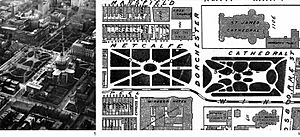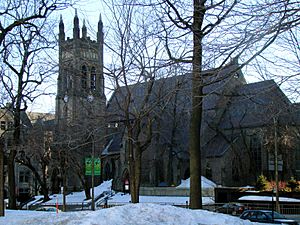Place du Canada facts for kids
Quick facts for kids Place du Canada |
|
|---|---|

Place du Canada from René Lévesque Boulevard.
|
|
| Lua error in Module:Location_map at line 420: attempt to index field 'wikibase' (a nil value). | |
| Type | Town square |
| Location | Downtown Montreal, Ville-Marie Montreal, Quebec, Canada |
| Area | 1.4 hectares (3.46 acres) |
| Created | 1876 (renamed 1967) |
| Operated by | City of Montreal |
| Status | Open all year |
Place du Canada is a big public space in downtown Montreal. It used to be part of a larger area called Dominion Square until 1967.
Contents
What is Place du Canada?
Place du Canada is a large public square in the heart of downtown Montreal. It covers about 14,000 square meters. That's a bit bigger than the park next to it, Dorchester Square.
This area slopes down towards De la Gauchetière Street. It has many well-kept plants and trees. These plants are placed to create different paths for people to walk through. The word place in French means a public plaza. This area is open all day, every day. It is surrounded by several streets: René Lévesque Boulevard to the north, Peel Street to the east, De la Cathédrale Street to the west, and De la Gauchetière Street to the south.

History of Place du Canada
Place du Canada was created between 1872 and 1876. It was officially opened in 1876 as Dominion Square. This area quickly became a very important spot in the city. It was a major place for transportation. Streetcars, taxis, and horse carriages all passed through here. By 1889, the Canadian Pacific Railway's Windsor Station was built nearby.
This square helped connect homes and suburbs to the west with the busy business area to the south. It served two main purposes. First, it helped manage all the different types of transport. Second, it offered a green, open space for people to rest and enjoy nature. It was a healthy break from the busy city.
From Cemeteries to a Park
Before it became a park, this area was used for several cemeteries. After a serious illness outbreak in 1851, many people were buried here quickly. Starting in 1854, the City of Montreal began moving the bodies from the Saint-Antoine Catholic Cemetery. They were moved to Notre-Dame-des-Neiges Cemetery. This allowed for the expansion of Dorchester Boulevard, which is now René-Lévesque Boulevard.
In 1869, St. George's Anglican Church was built here. This spot was once a Jewish cemetery. Soon, other churches were built in the same area. This made the location a very desirable place to live and build.
In 1869, people suggested that the city buy the old Catholic cemetery. They wanted to turn it into a public park. This would prevent any issues from the old burial ground. The city bought the land in 1870 and started landscaping it. In 1872, it was named Dominion Square. This name came from Canada, which had just formed in 1867.
Growth and Renaming
In the 1870s, the Mary, Queen of the World Cathedral was built nearby. It looks like a smaller version of St. Peter's Cathedral in Rome. By 1889, Windsor Station became a major landmark. The square provided a direct path to the station.
In 1895, the Macdonald Monument was built in the northern part of the square. This monument honors John A. Macdonald, Canada's first Prime Minister. The monument shows different jobs and industries from Canada's early days. It faces west-northwest, looking over the city.
In 1967, Canada celebrated its 100th birthday. To mark this special year, the southern part of Dominion Square was renamed Place du Canada. From then on, the northern and southern parts of the park had different names.
Place du Canada was also the site of a very large event. On October 27, 1995, a huge political gathering called the Unity Rally took place here. About 100,000 Canadians came to show their support for a united Canada. They asked people in Quebec to vote "No" in the 1995 Quebec independence referendum. This vote happened just three days later.

Monuments and Statues
Place du Canada has several important monuments:
- John A. Macdonald Monument: This statue honors Canada's first Prime Minister. It was created by George E. Wade in 1895.
- Montreal Cenotaph: This monument was built in 1924. It is a copy of the Cenotaph in London, England. It honors soldiers who died in war.
- Two cannons: These cannons were given to the city by Queen Victoria in 1889.
- Mitrailleuse: This is a type of early machine gun.


